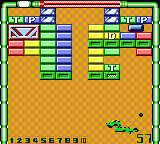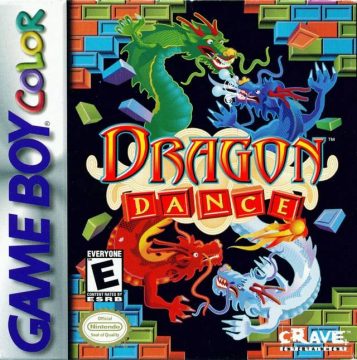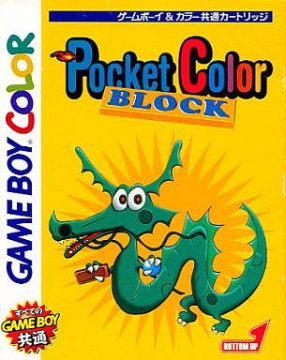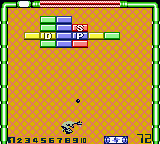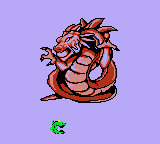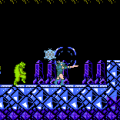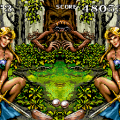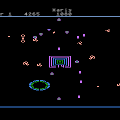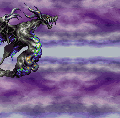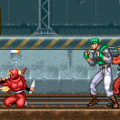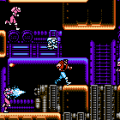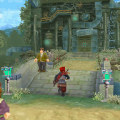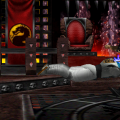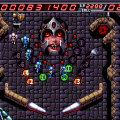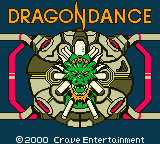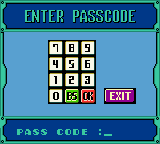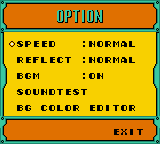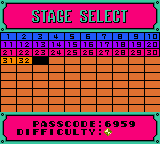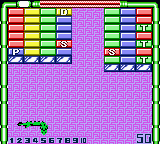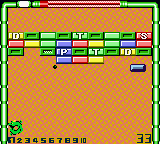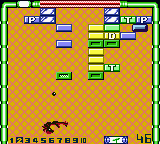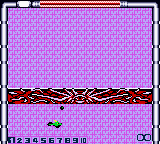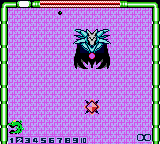In Dragon Dance, a brick-breaker game for the Game Boy Color, the player is a green eastern-style dragon who uses his body as a paddle to bounce a ball against blocks. The player can move left and right like any normal Breakout/Arkanoid style game, but can also move slightly up and down. Also, when the player is not hitting left or right or goes against a wall, the dragon will curl up into a ball, keeping players always on their toes when trying to hit the ball.
The player technically has four lives, which are lost by having the ball go below the screen as usual. Every time a live is lost, the dragon loses length, eventually becoming the size of a tadpole. The game also gives a time limit on levels, and while the player can get their length back by breaking blocks with the letter P on them, the player can also get extra time by breaking blocks with the letter T on them. The player can also increase their top speed by breaking blocks with the letter S on them. The player also has a meter that fills up when at least two blocks are hit in a row without the player having to bounce the ball. If the player lets the meter fill up a quarter of the way, they can become a blue dragon that freezes the time and can also freeze the ball in place. Letting the meter fill up half way lets the player become a white dragon that can give the ball an extra bounce in mid-air. Letting the meter fill three quarters of the way lets the player become a black dragon that can create a barrier for the ball to bounce off of. Letting the meter fill near the top lets the player become a red dragon that has the obligatory projectile power-up. Having the meter fill up all the way summons a giant red dragon that causes the screen to shake and destroys most of the level for the player.
The default speed for the ball is generally pretty slow. However, the player can speed it up by hitting select, up to a total of ten times. When the ball goes off the field, its speed reverts back to the first setting. On one hand, playing with the speed can be useful in situations when the timer is almost out, or the player just wants to clear a level faster. On the other hand, increasing the speed increases the risk of the ball going off of the field. The ball can be slowed down by breaking blocks with the letter D on them. The game introduces different kinds of blocks throughout the levels, such as blocks that take two hits to take out, indestructible blocks, blocks that move around, and crates that are destroyed once all the blocks below them are taken out. The game goes on for 100 levels, and ranks them in difficulty between one and five gems. The game stops introducing new mechanics around level 20, and instead puts the mechanics previously given to the test. Some of the levels are brutally difficult and sometimes seem cheap. Thankfully, the player can skip any of the levels with a passcode.
Every ten levels, the player fights against a boss character. Some of these bosses are pretty awesome such as a knight which throws a boomerang at you. Others, such as a wall that just descends and does nothing else, feel lazy and rush. The final boss, at level 100, has two forms, and unique theme music for each form. The graphics of this game get the job done, but do not feel that unique. They don’t try anything particularly special with how the bricks, items, or scenery look, and if the dragon were just a regular paddle, this could be seen as a regular breakout game without any special features. The music feels a bit lacking, as there is only one level theme and one theme for the bosses (except the final one), but it’s at least better than no music at all. The sound effects aren’t particularly interesting either, but don’t necessarily feel bad by any means. Possibly a new level theme every 20 levels or so would have been nice. Unlike some breakout games such as arkanoid and wizorb, there are no enemies to destroy outside of bosses, and this can make the game seem kind of boring to those watching it. There is also a versus mode in the game, where two players compete to see who survives the longest. On ten second intervals, random cards pop up that do things such as make the blocks go up or down, as well as various other effects. It seems like a haphazard attempt at multiplayer thrown in at the last minute, and doesn’t feel particularly fun to play. While this game does genuinely have some original ideas like the power-up bar, your length decreasing as you lose lives, curling up into a ball, and speeding up the ball automatically, the rest of the game feels kind of uninteresting by comparison.
The game probably didn’t get much of attention due to being a Breakout-type game on the Game Boy Color in the year 2000, which by that point had games with much more depth and content. Compounding that is that half the game seems very bland while the other half has a lot of genuinely interesting gimmicks. Today, it’s a hidden gem, and while a good chunk of it is run of the mill, it has a lot of interesting ideas that still let it hold up today if one is willing to tolerate its flaws.
